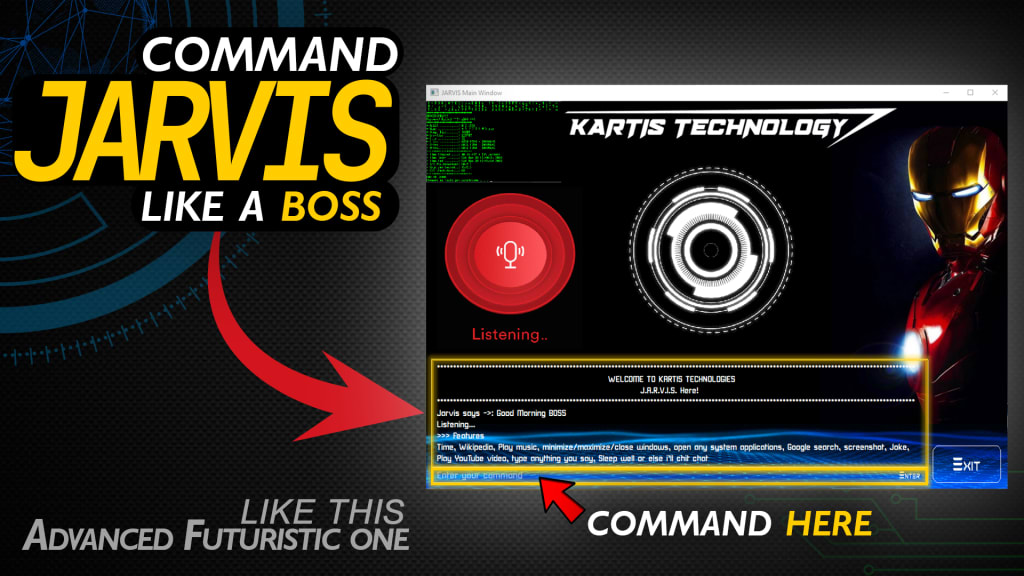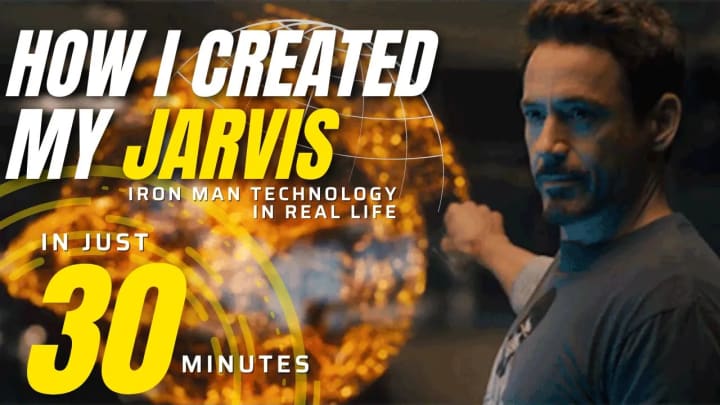Futuristic AI J.A.R.V.I.S in real life
A Simple Robot Assistant anyone can create

Creating your own AI can be a challenging but rewarding task. It requires a strong understanding of computer science, mathematics, and machine learning concepts. The first step in creating your own AI is to determine what type of AI you want to build. This could be anything from a simple chatbot to a sophisticated self-driving car. Once you have a clear idea of what you want to build, you can begin to gather the necessary data and resources. This might include collecting large sets of data to train your AI model, as well as finding and using appropriate tools and libraries. Building your own AI also requires a lot of experimentation and iteration. You will likely encounter many obstacles and setbacks along the way, but with perseverance and determination, you can create an AI that is capable of performing a wide range of tasks.
I started by reading books, took online courses and attended workshops to deepen my understanding of computer science, mathematics and other topics. Once I had a solid foundation, I set out to determine what type of AI I wanted to build. I decided to create a chatbot that could converse with users on a specific topic and also do some functions which I would like to do.
The next step was to gather the necessary data and resources. I collected a large dataset of conversations on the topic of my choice and used it to train my AI model. I also found and used appropriate tools and libraries that helped me to develop my JARVIS Assistant. It was a process of trial and error, experimenting with different algorithms and techniques. I faced many obstacles and setbacks while doing the GUI (Graphical User Interface) part, but with perseverance and determination, I was able to create an Assistant bot that could converse with users on the topic with a high level of accuracy.
I wanted it to be able to perform voice commands, control smart devices, play music, and provide information. I studied natural language processing, speech recognition, and internet of things (IoT) protocols.
In the end, I was able to create a JARVIS that could perform a wide range of tasks and make my life more convenient. It was a great learning experience and I'm proud of what I was able to accomplish. I encourage anyone who is interested in technology to try creating their own JARVIS, it's a fun and rewarding endeavor.
The experience of creating my own JARVIS taught me a lot about the possibilities and limitations of AI technology. It also helped me to understand how AI can be used to solve real-world problems and improve our daily lives.
"I believe that anyone with a passion for technology and a willingness to learn can create their own AI, and I encourage others to give it a try."
This is the Demo video of the JARVIS Assistant which we are talking about. It will be worth to click on the video and watch it:
In this video, I've shown my automated voice controlled Program named as JARVIS after Tony Stark's Artificial Intelligence in the movie called IRON MAN who can do lot of activities with his Speech Recognition Tech as Pre-programmed effectively.
This Jarvis project was done just for Experimental and Educational purpose and this program needs more Improvement such as Machine Learning and Deep learning algorithms should be added to make it a complete Artificial Intelligence (AI). This program is a basic outline of how a AI should be. In future, I'll be developing a complete AI as of like JARVIS with a Artificially Created Neural Network.
I have also taught about "How to create your own JARVIS ?" in my YouTube channel named KARTIS.
You can find the Tutorial playlist by clicking here.

And a complete JARVIS with GUI Tutorial in here.

Here are some steps you can take to create your own AI:
- Determine the problem you want to solve: Identify a specific problem or task that you want your AI to solve, such as image recognition, natural language processing, or self-driving cars.
- Gather data: Collect a large dataset that your AI will use to learn from. The more data you have, the better your AI will perform.
- Preprocess the data: Clean, organize, and prepare the data for training. This will help to improve the performance and reduce the complexity of your AI.
- Choose an appropriate algorithm: Select the best algorithm for your problem, such as supervised learning, unsupervised learning, or reinforcement learning.
- Train the model: Use the data and algorithm to train your AI model. This will involve adjusting the parameters of the model to minimize the error between the predicted and actual output.
- Evaluate the model: Test the AI model on a new dataset to evaluate its performance.
- Deploy the model: Once your AI model is trained and evaluated, you can deploy it in a real-world application.
Please note that creating an AI can be a very complex task, it requires a deep understanding of the field, programming skills, and access to powerful computational resources. Additionally, creating an AI system that can perform human-like tasks, such as those in the movies, requires a lot of resources, time and expertise in the field.
About the Creator
KARTIS
True passion for technology is not just about knowing how it works, it's about understanding how to make it work for you.
Enjoyed the story? Support the Creator.
Subscribe for free to receive all their stories in your feed. You could also pledge your support or give them a one-off tip, letting them know you appreciate their work.






Comments
There are no comments for this story
Be the first to respond and start the conversation.